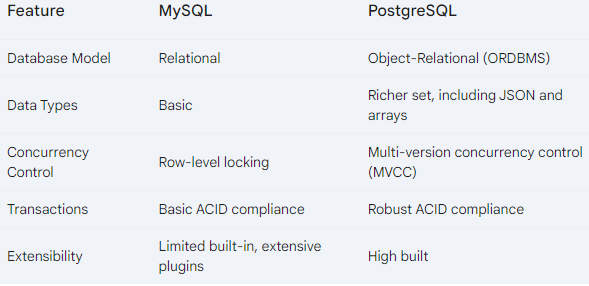MySQL vs PostgreSQL: Choosing the Right Database for Your PHP Web App

The backend database is the backbone of any web application, silently handling data storage, retrieval, and manipulation. For PHP developers, MySQL and PostgreSQL are the two most popular choices. Both offer robust features and seamless integration with PHP, but they cater to different needs. This article delves into the key differences between MySQL and PostgreSQL, helping you choose the ideal database for your PHP web app project.
Understanding MySQL and PostgreSQL
MySQL:
An open-source relational database management system (RDBMS) renowned for its speed, ease of use, and widespread adoption. It’s a mature technology with a vast community and extensive documentation. MySQL excels in:
- Read-heavy workloads: Ideal for applications with frequent data retrieval, like content management systems (CMS) or e-commerce platforms.
- Simple web applications: Perfectly suited for smaller projects with basic database needs.
- Performance: Offers exceptional performance for read operations and straightforward queries.
PostgreSQL:
Another open-source RDBMS, known for its flexibility, advanced features, and data integrity. It adheres more strictly to SQL standards and offers functionalities absent in MySQL. PostgreSQL shines in:
- Complex data models: Well-suited for applications requiring intricate data relationships and advanced data types (JSON, arrays, etc.).
- Data integrity: Offers robust features like ACID transactions and foreign keys to ensure data consistency.
- Scalability: Can handle large datasets and high-concurrency workloads efficiently.
Key Differences to Consider
While both databases excel in their own right, several key differences can influence your choice:
Database Model:
- MySQL: Primarily a relational database, focusing on structured tables with rows and columns.
- PostgreSQL: An object-relational database (ORDBMS) that extends the relational model with object-oriented features like inheritance and function overloading.
Data Types:
- MySQL: Supports common data types like integers, strings, and dates.
- PostgreSQL: Offers a wider range of data types, including geometric objects, arrays, and JSON.
Concurrency Control:
- MySQL: Uses row-level locking, which can lead to bottlenecks in high-concurrency scenarios.
- PostgreSQL: Employs multi-version concurrency control (MVCC), improving performance under heavy workloads.
Transactions:
- MySQL: Offers basic transaction support but may face challenges in complex scenarios.
- PostgreSQL: Provides robust ACID (Atomicity, Consistency, Isolation, Durability) compliant transactions for data integrity.
Extensibility:
- MySQL: Limited built-in extensibility, but a vast ecosystem of third-party plugins exists.
- PostgreSQL: Highly extensible with built-in support for user-defined functions, procedures, and triggers.
Security:
- MySQL: Offers standard security features like user authentication and access control.
- PostgreSQL: Provides advanced security features like role-based access control (RBAC).
Community and Support:
- MySQL: Enjoys a larger and more active community with readily available resources.
- PostgreSQL: Has a smaller but equally supportive community with well-documented features.
Cost:
- MySQL: Open-source and freely available, with various commercial support options.
- PostgreSQL: Open-source and free to use, with commercial support options from third-party vendors.
Choosing the Right Database for Your Project
The ideal database for your project hinges on several factors:
- Project Complexity: For simpler web applications with basic data needs, MySQL’s speed and ease of use might be preferable.
- Data Model Complexity: If your application requires intricate data relationships or advanced data types, PostgreSQL is a better fit.
- Scalability Needs: For applications anticipating high-concurrency workloads or massive datasets, PostgreSQL’s robust features shine.
- Transaction Management: If robust data integrity through ACID transactions is crucial, PostgreSQL is the clear choice.
- Development Team Expertise: If your team has more experience with MySQL, the learning curve for PostgreSQL might be a factor to consider.
Here’s a table summarizing the strengths of each database to aid your decision:

Beyond the Core Differences: Additional Considerations
While the core functionalities are crucial, some additional factors can influence your decision:
- Performance Optimization: Both MySQL and PostgreSQL offer performance tuning options. However, due to its simpler architecture, MySQL might be easier to optimize for specific workloads.
- Cloud Integration: Both databases integrate seamlessly with major cloud platforms like AWS, Azure, and GCP. Evaluate your preferred cloud provider’s specific offerings for each database.
- Development Tools and Frameworks: Many popular PHP frameworks like Laravel, Symfony, and CodeIgniter offer built-in support for both MySQL and PostgreSQL. Check if your chosen framework provides any specific advantages for either database.
- Long-Term Maintenance: Consider the ongoing maintenance needs of your application. PostgreSQL’s advanced features might require a deeper understanding for future maintenance compared to MySQL.
Making an Informed Decision
By carefully evaluating your project requirements against the strengths and weaknesses of MySQL and PostgreSQL, you can make an informed decision. It’s also not uncommon for some applications to leverage both databases. Here are some scenarios where this might be beneficial:
- Hybrid Approach: Use MySQL for the primary application data and PostgreSQL for a specific feature requiring advanced functionalities, like a complex search engine.
- Read Replicas: Set up read replicas of your MySQL database on PostgreSQL for handling high read traffic, while keeping the write operations on the primary MySQL instance.
Ultimately, the best database choice depends on your specific project’s needs. Consider creating prototypes using both MySQL and PostgreSQL to assess their performance and suitability for your application’s unique use case.
Additional Resources
This article has provided a high-level comparison of MySQL and PostgreSQL. Here are some additional resources for further exploration:
- MySQL Documentation: https://dev.mysql.com/doc/
- PostgreSQL Documentation: https://www.postgresql.org/docs/
- Choosing the Right Database for Your Application (MySQL vs. PostgreSQL): https://kinsta.com/topic/mysql-database/
- Working with PHP and Databases: MySQL vs. PostgreSQL: https://medium.com/@articles_92466/postgresql-vs-mysql-fe9d65887520
By leveraging the information in this article and the provided resources, you can make a well-informed decision about the ideal database for your next PHP web app project. Remember, the most suitable database is the one that empowers you to build a robust, scalable, and efficient application that meets your specific requirements.
